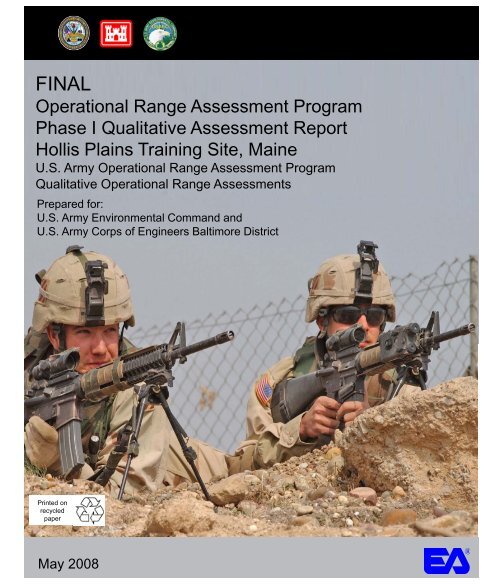Hollis Plains Training Site
Hollis Plains Training Site
Hollis Plains Training Site
- No tags were found...
Create successful ePaper yourself
Turn your PDF publications into a flip-book with our unique Google optimized e-Paper software.
Operational Range Assessment Program, Phase I Qualitative Assessment Report<strong>Hollis</strong> <strong>Plains</strong> <strong>Training</strong> <strong>Site</strong>, MaineMay 2008EXECUTIVE SUMMARYThe United States (U.S.) Army is conducting qualitative assessments at operational ranges to meet therequirements of Department of Defense policy and to support the U.S. Army Sustainable RangeProgram. The operational range qualitative assessment (hereinafter referred to as Phase IAssessment) is the first phase of the U.S. Army Operational Range Assessment Program (ORAP).This Phase I Assessment evaluates the operational range area at <strong>Hollis</strong> <strong>Plains</strong> <strong>Training</strong> <strong>Site</strong> (TS) toassess whether further investigation is needed to determine if potential munitions constituents ofconcern (MCOC) are or could be migrating off-range at levels that may pose an unacceptable risk tohuman health or the environment. In conducting the Phase I Assessment, MCOC sources, potentialoff-range migration pathways, and potential off-range human and ecological receptors are evaluatedas appropriate.<strong>Hollis</strong> <strong>Plains</strong> TS is a 408.18-acre installation located in the Town of <strong>Hollis</strong>, in York County, one-halfmile northeast of North <strong>Hollis</strong>, Maine. The Maine Army National Guard (MEARNG) owned theproperty from 1967 to 1968. In 1969 the MEARNG transferred the property to the State of Maine.Use of the training facility decreased from mid 1980s through the 1990s and the TS has not been usedregularly (less than 1 time per year) since the late 1990s. Army Range Inventory Database-Geodatabase (ARID-GEO) (2007) identifies a 2.61-acre inactive baffled firing range, and twomaneuver and training areas totaling 405.57 acres. Historically, three additional ranges, including apistol, rifle, and demolition training range were located at the installation.The primary sources of MCOC identified at <strong>Hollis</strong> <strong>Plains</strong> TS are the impact berms associated with theinactive small arms firing range and historic rifle range, and target pits associated with the historicpistol range. In general, MCOC from these source areas potentially impact soil in the impact bermsand target pits. However, the mitigating effects of on-range wetlands serve to limit the potential forMCOC migration to off-range areas. Furthermore, soils samples collected from both historic smallarms ranges were non-detect or below state clean up criteria for lead. Therefore, it is unlikely thatpotential MCOC from these operational ranges would result in an unacceptable risk to human healthor the environment.The three operational ranges at <strong>Hollis</strong> <strong>Plains</strong> TS are categorized as Unlikely.Unlikely – Five-Year ReviewThree ranges at <strong>Hollis</strong> <strong>Plains</strong> TS are categorized as Unlikely, totaling 408.18 acres. These rangesconsist of an inactive small arms range and maneuver and training areas. Based upon a review ofreadily available information, ranges where there is sufficient evidence to show that there are noknown releases or source-receptor interactions off-range that could present an unacceptable risk tohuman health or the environment are categorized as Unlikely. Ranges categorized as Unlikely arerequired to be re-evaluated at least every five years. Re-evaluation may occur sooner if significantchanges (e.g., change in range operations or site conditions, regulatory changes) occur that affectdeterminations made during this Phase I Assessment.Table ES-1 summarizes the Phase I Assessment findings.EA Engineering, Science, and Technology, Inc.ES-1
Operational Range Assessment Program, Phase I Qualitative Assessment Report<strong>Hollis</strong> <strong>Plains</strong> <strong>Training</strong> <strong>Site</strong>, MaineMay 2008Table ES-1: Summary of Findings and Conclusions for <strong>Hollis</strong> <strong>Plains</strong> <strong>Training</strong> <strong>Site</strong>CategoryUnlikelyTotal Number ofRanges andAcreage Source(s) Pathway(s)3 operationalrange; 408.18acresNo source – limitedof no militarymunitions useInactive firing rangeHistoric firingrangesHumanEcologicalReceptors ReceptorsNot evaluated (no MCOC source was identified)On-rangewetlands to offrangewetlandsOn-rangewetlands to offrangewetlands,surficial aquiferto off-rangewetlandsRecreational usersof Little OssipeeRiverRecreational usersof Little OssipeeRiver and KillickPondWetlands, statewildlife managementareas, AtlanticsalmonWetlands, statewildlife managementareas, Atlanticsalmon, eastern boxturtlesConclusions and RationaleRe-evaluate during the five-yearreview. No source was identified.Re-evaluate during the five-yearreview. Limited potential for offrangemigration was identified.Re-evaluate during the five-yearreview. Limited potential for offrangemigration was identified.EA Engineering, Science, and Technology, Inc. ES-2
















